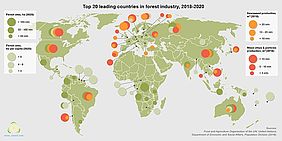Global Forest Resources Assessment 2020 published by the Food and Agriculture Organization (FAO) of the United Nations provides a complete picture of the world's forests and an understanding of how this resource was changing in the period from 1990 to 2020 in 236 countries and territories.
According to the report, forested area on the planet is 4.06 billion hectares (ha), which is 31% of the total land area. The largest proportion of the world’s forests are tropical (45%), ahead of boreal, temperate and subtropical. 54% of the world’s forests are found in only five countries – the Russian Federation (20%), Brazil (12%), Canada (9%), the United States of America (8%) and China (5), the remaining 46% is distributed throughout the rest of the world.
In the 30-year period examined, the global forest area declined by about 178 million ha. This area is comparable in size to the territory of Libya. Although the area of the forests decreases every year, some positive trends can be seen in the rate of loss, which is slowing down. In the decade 1990-2000 the forest area declined 7.8 million ha per year, in 2000-2010 – 5.2 million ha per year and in 2010-2020 – 4.7 million ha per year.
Not everywhere in the world has the rate of forest loss slowed; in Africa it has increased in each of the three decades since 1990, and the continent had the largest annual rate of net forest loss in 2010–2020, at 3.9 million ha. Although South America, with minus 2.6 million ha, had the second-highest average annual rate of net forest loss in 2010–2020, it has reduced its forest loss to about half the rate compared with 2000-2010. This tendency mostly reflects positive changes in Brazil, where the annual rate dropped to 1.50 million ha in 2010-2020 compared with 3.95 million ha in 2000–2010. North and Central America lost about 0.1 million ha.
Between 2010 and 2020, the largest net gains in forest area were in Asia (+ 1.2 million ha) with China as a main contributor to this increase. Oceania recorded the second-largest average annual net gain in forest area (+0.4), mainly driven by Australia. Europe (+0.3) is in third position, whereby France, Italy and Romania have recorded the maximum average annual net gains in a forested area on the continent. About 93% (3.75 billion ha) of the world’s forested areas has regenerated naturally, the rest (290 million ha) is planted.
Worldwide, about 30% (1.15 billion ha) of forest is used primarily for the production of wood and non-wood forest products. In addition, 749 million hectares are intended for multi-purpose use, which commonly includes production. 424 million ha of the world's forests is designated for biodiversity conservation (a 111 million ha increase since 1990), while 398 million ha of forest is designated for the protection of soil and water (a 119 million ha increase since 1990). An area of 186 million hectares of forest has been allocated for social services such as tourism, educational research, and the preservation of cultural and spiritual sites.
According to Yearbook of Forest Products 2018, the latest available FAO’s statistic on global production and consumption of wood products, 2018 was an all-time record year for global production, imports and exports of all major wood products – roundwood, sawn wood, wood-based panels, wood pulp, wood charcoal and pellets. In 2018, roundwood removals worldwide increased by 5% to a record 2.03 billion m3, raising global trade 7% to a record 138 million m3, of which 43 percent was imported by China. New Zealand became the leading exporter of industrial roundwood in 2018, overtaking the Russian Federation.
For the paper industry, 2018 was not such a strong year. After continuous slow growth in 2014-2017, global paper and paperboard production fell by about 2%, mainly due to disruptions in the supply of recovered paper and the continued replacement of printed media with digital products. China and USA were the largest paper producers in 2018; together they account for about 175 million tonnes, which makes 43% of global production.
In addition, the production of wood pellets deserves special attention, which has increased dramatically in recent years, mainly due to the demand for bioenergy targets set by the EU. In 2018, global production increased by 11% to 37 million tons with Europe and Northern America accounting for most of the global production. The top five pellets producers in 2018 were the USA, Canada, Vietnam, Germany and Sweden. Europe accounted for 75% and Asia-Pacific for 18% of global pellet consumption in 2018.
The Food and Agriculture Organization notes that globally the trend is moving to more sustainable management of forest resources and forest monitoring capacity is greater than ever, but urgent action is needed “if the world is to meet commitments to halt deforestation, increase forest area, and restore 350 million ha of the world’s deforested and degraded land”.
